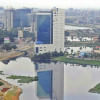Hatirjheel: A City Respite

One of the pleasures of my daily commute to work is experiencing the lakefront at Hatirjheel. Not always can you write pleasure and commute in one sentence when it comes to Dhaka. I look at the disciplined queue of people availing water taxis, at a controlled number of public buses, reflecting on an ideal cityscape. I guess only our olive-clad brothers can claim such city serenity while staying not far from the madding crowd. For the rest of Dhakaites, the place is a pleasant respite.
This integrated development of the Hatirjheel and Begunbari areas recently earned a bronze prize in the landscape architecture/urban design category awarded by the Architecture MasterPrize. In its citation, the award committee hails the "Urban Oasis" for symbolising "a remarkable example of environmental restoration and remain[ing] as a source of inspiration for environmental restorations throughout Bangladesh."
Little did the awarding agency know that inspiration is not an incentive for the current management authority of the project, which includes multiple stakeholders, including Bangladesh Water Development Board (BWDB), Rajdhani Unnayan Kartripakkha (Rajuk), the Department of Environment, the Local Government Engineering Department (LGED), and the city corporation. The sustainability of the project depends on the coordination among these public offices. With the contract period for post-handover service coming to an end, the government agencies are back to their proverbial bureaucratic entanglement. The unkempt gardens and footpaths as well as the wears and tears are tell-tale signs of mismanagement.
While doing a background check for this piece, I came to learn that the annual maintenance cost of the project is about Tk 18 crore, Tk 7 crore of which is required to purify the lake water. The project runs on a deficit as only Tk 10 crore is earned through renting commercial spaces and other services. The intra-ministerial agencies are not willing to cover the deficit. On June 30, 2021, the High Court intervened with its directive to declare Hatirjheel as a public trust property. While the High Court's recommendations are ideal, one of them decreed the removal of commercial places like the eateries from the lakefront. Last month, a stay order on the High Court decision was issued by the Appellate Division of the Supreme Court. The status quo suggests a lack of planning in making the project sustainable for the long term.

Earlier this year, as if to symbolically protest the ill health of Hatirjheel, we had hundreds of dead fish shoring up to make a public statement. All is not well in the state of Hatirjheel (at least with the oxygen level in the water). Yet, this spot started with a huge promise of changing our cultural map. For joggers, this can be a good spot for a run. For the aimless walkers, the waterside promenades featuring a dancing fountain and illuminated bridges offer a visual feast. For families, this is a pleasant respite after a day's work to spend some quality time close to nature. For commuters, this is a much-needed corridor that connects the two sides of Dhaka. From a city management perspective, Hatirjheel preserves a low-lying floodplain area to save our roads from being inundated during the monsoon.
The benefits are endless compared to the maintenance cost over which our agencies are quibbling. If they keep on ignoring the site, the next phase of restoration will be even more expensive.
The waste that travels from the surrounding areas such as Karwan Bazar, Panthapath, Dhanmondi, Kalabagan, Kathalbagan and Banglamotor will not stop falling into Hatirjheel. Unless the waste disposal system is enacted and systematically maintained, what promises to be a city lung can be a source of pollutants. For a city ranked among the top 10 unliveable ones, we can ill-afford another location that wreaks havoc on the environment.
There is currently another proposal of connecting Gulshan South Park and Gulshan Lakeway with Hatirjheel. The Dhaka North mayor has proposed expanding the waterway by elevating the land bridges that will improve the waterfront legacy of the capital. This is probably a good idea as it will increase water-based modes of transportation. The popularity of this alternative model can be used to encourage it in other canals and rivers. There have been several abortive attempts to introduce water taxis between Uttara/Ashulia and Sadarghat.
Hatirjheel is a precious asset for Dhaka that needs our undivided attention. Given the presence of star-studded hotels in the vicinity, this place can be turned into a tourist spot with the right kind of investment. The sustainability of the place will depend on the right balance of environmental protection and resource management. The beauty of the project can be further increased by making the local community its stakeholders. The building authority, Rajuk, for instance, can insist on maintaining strict colour codes that blend with the landscape. Many new real estate companies are trying to find outlets to bypass roads, which should be closely monitored.
Above all, security in Hatirjheel should be ensured to earn the confidence of visitors. Now and then, we hear that the police work in cahoots with the miscreants, which is symptomatic of another illness that the Hatirjheel witnesses on a daily basis.
Dr Shamsad Mortuza is a professor of English at Dhaka University.

 For all latest news, follow The Daily Star's Google News channel.
For all latest news, follow The Daily Star's Google News channel. 









Comments